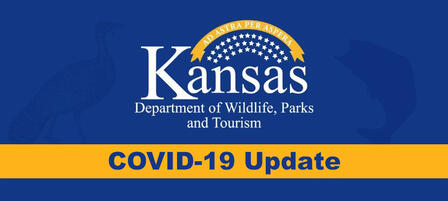KDWPT And Wildlife Rehabilitators Partner to Protect Wildlife Against Virus

PRATT – As data continues to emerge from the rapidly evolving COVID-19 pandemic, the Kansas Department of Wildlife, Parks and Tourism (KDWPT) is proactively putting measures in place to protect Kansas wildlife. Partnering with the state’s permitted wildlife rehabilitation facilities, KDWPT originally advised wildlife rehabilitation permit holders to temporarily cease the release of any rehabilitated wildlife in an effort to limit potential transmission of the SARS-CoV-2 virus to wild populations. With new scientific information available, KDWPT now allows the release of rehabilitated birds, reptiles and amphibians; there is currently no evidence the virus negatively affects these animals, and little to no shedding of the virus has been documented in several bird studies.
Further studies are needed to understand if and how different mammal species could be affected by the virus that causes COVID-19, as well as how this might affect human health. Studies documenting human to wildlife transmission are currently lacking, so KDWPT biologists stress the need to take caution until research indicates there is no danger of transmission for select species and/or staff have the ability to test mammals prior to release.
“There is evidence the virus has been transmitted from people to species like cats, dogs and mink. Models also suggest bats are at higher risk of contracting the virus from humans,” KDWPT wildlife disease coordinator Shane Hesting said. “These cases have been few in number, and scientists are trying to figure out how these types of transmissions occur. The concern is people transmitting the virus to animals, and the infected animals transmitting the virus back to people and/or transmitting it to more animals, hurting their populations.”
KDWPT recently issued a guidance document to all permitted wildlife rehabilitation facilities outlining the department’s new wildlife handling protocol. Under the new guidelines, licensed rehabilitation facilities may continue taking in new animals as long as they have the capacity and ability to safely house mammals for an undetermined amount of time.
“To err on the side of safety is a good approach,” Dennis Dinwiddie, director of conservation and education at the Topeka Zoo and current director of the Northeast Kansas Wildlife Rescue said.
In his 24 years of involvement with the rescue group, Dinwiddie has seen new viruses jump from one species to another, including the West Nile outbreak in the early 2000s.
“For the first year, we were encountering West Nile in birds, and we thought birds were the only ones that were affected. Eventually, we found out that squirrels were starting to die from the virus, as well,” Dinwiddie said. “We have historical precedence to demonstrate that we need to make sure we know how it impacts our wildlife before we jump to conclusions.”
Marty Birrell, nature interpretive supervisor for the city of Lawrence, mirrors Dinwiddie’s sentiments.
“There isn’t enough research yet,” Birrell said. “Because of that, we need to be especially cautious. We need to keep the virus from crossing into wildlife populations by avoiding exposure through people.”
Wildlife rehabilitation facilities are already seeing an increase in animal intake due to well-meaning individuals bringing in what they believe are orphaned young. Often in these cases, the mother is actually nearby gathering food or keeping away predators. This year, more than ever, KDWPT and rehabilitation facilities stress the need to “leave wildlife wild” in order to stay under capacity and to help the animals that are truly in need. If you’re unsure if an animal needs rescued, Birrell added that the best course of action is simply to call a rehabilitation center before removing the animal from the wild.
“When you call, rehabilitators can assess whether or not an animal is actually injured or orphaned,” Birrell said. “Based on the information we receive, we can determine if the animal needs intervention.”
“Sometimes animals are sick and harbor zoonotic diseases that can make people ill or even cause death,” Hesting said. “Sick wildlife should be reported to KDWPT; staff will make the decision to screen the animal based on symptoms.”
As with nearly all precautionary measures put in place in response to the COVID-19 pandemic, the duration of KDWPT’s new wildlife handling protocol will be determined by the best available data at the time. Until then, KDWPT staff will continue working with other states to determine transmission threats, obtain available testing, and communicate findings regularly with the state’s wildlife rehabilitation community.
For more on wildlife diseases, and wildlife rehabilitation in Kansas, visit https://ksoutdoors.com/Services/Rehabilitation.
For more information on COVID-19 in Kansas, visit covid.ks.gov.
-30-









